¿Por qué sonríe la Virgen de la Catedral de León? / Why does the Virgin of the Cathedral of León smile?
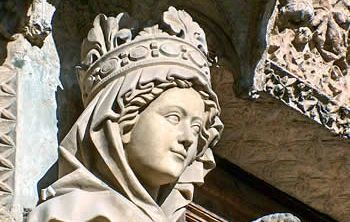
http://poramoralarte3.blogspot.com.es/2011/03/virgen-blanca-de-la-catedral-de-leon.html
¡Hola amigos!
En la portada de la Catedral de León me llamó mucho la atención la sonrisa de la Virgen. ¿Por qué sonríe? ¿Cuál es la explicación?
La Virgen de la portada principal de la Catedral de León es Nuestra Señora La Virgen Blanca y destaca por su sonrisa. Es una de las esculturas más destacable del gótico español. En efecto, en esta figura hay una elegancia, una ironía y una especie de complicidad maternal. Esta humanidad apareció en el arte gótico porque antes no existía en el románico. En el gótico se intenta trasmitir humanidad y de esta forma se rompe con el arte más antiguo.
Hello friends!
On the cover of the Cathedral of Leon I was very struck by the smile of the Virgin. Why do you smile? What is the explanation?
The Virgin of the main cover of the Cathedral of León is Our Lady The White Virgin y noted for her smile. It is one of the most remarkable sculptures of Spanish Gothic. In effect, in this figure there is an elegance, an irony and a kind of maternal complicity. This humanity appeared in Gothic art because before it did not exist in Romanesque. In the Gothic is trying to transmit humanity and this way it breaks with the oldest art.
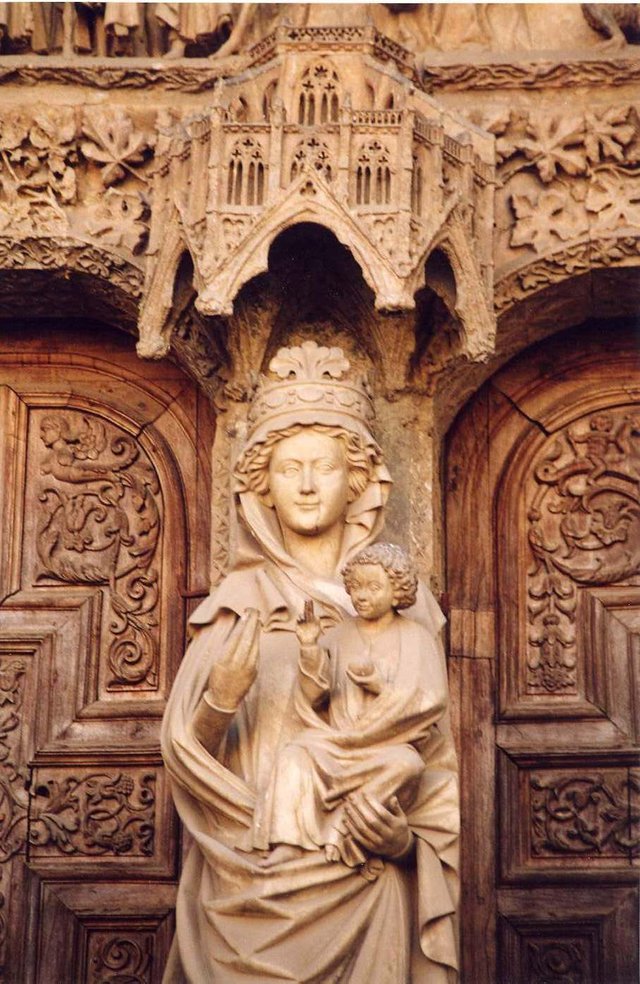
La Virgen se presenta empatizando con sus devotos espectadores. La Virgen está alegre, como cualquier madre, posando con el niño en brazos. Con ello, los escultores del siglo XIII querían indicar que también es madre de los cristianos y velará por ellos.
The Virgin presents herself empathizing with her devout spectators. The Virgin is happy, like any mother, posing with the child in her arms. With this, the sculptors of the thirteenth century wanted to indicate that she is also the mother of Christians and will watch over them.
El Virgen está instalada en el parteluz del pórtico del Juicio Final. No es casual, pues con su sonrisa los artistas medievales indicaron que ella, la madre, intercederá ante Dios Cristo en el momento del Juicio Final. Intenta dar confianza al creyente de que, al final, se hará justicia y de que su fervor será bien compensado. Como reza el Ave María: *“Santa María madre de Dios ruega por nosotros pecadores ahora y en la hora de nuestra muerte.” *
The Virgin is installed in the mullion of the portico of the Last Judgment. It is not accidental, because with his smile the medieval artists indicated that she, the mother, will intercede before God Christ at the moment of the Final Judgment. Try to give confidence to the believer that, in the end, justice will be done and that his fervor will be well compensated. As the Hail Mary says: * "Holy Mary, mother of God, pray for us sinners now and at the hour of our death." *
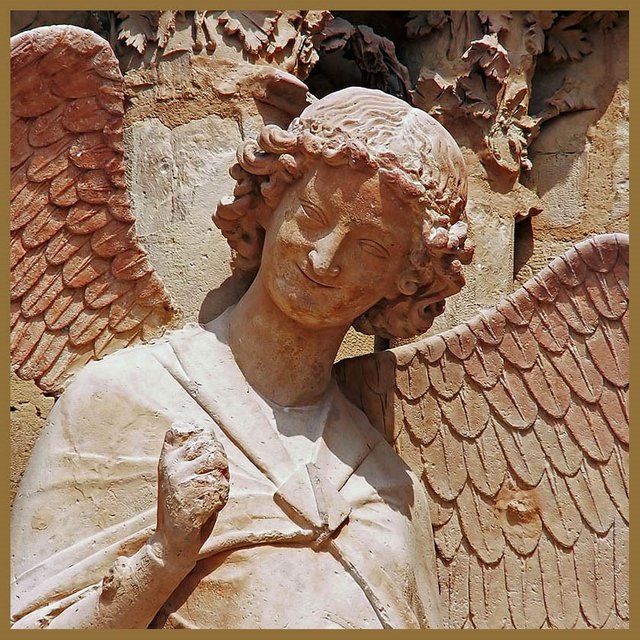
http://domuspucelae.blogspot.com.es/2012/08/visita-virtual-la-virgen-blanca.html
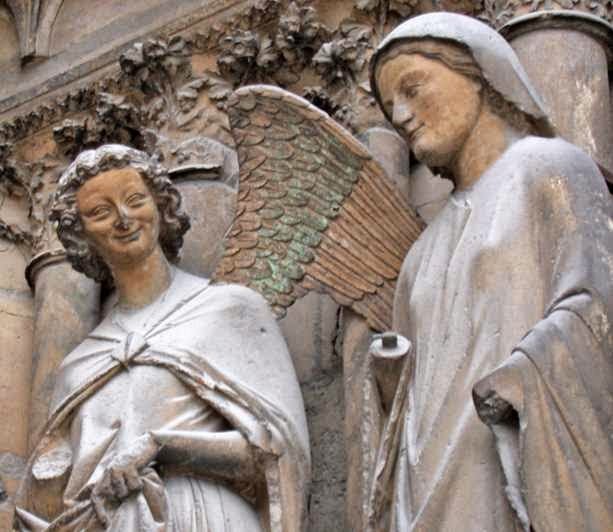
http://domuspucelae.blogspot.com.es/2012/08/visita-virtual-la-virgen-blanca.html
La primera sonrisa que apareció en las esculturas fue la del ángel anunciador del pórtico de la catedral de Reims. Esta sonrisa era un gesto totalmente atípico e innovador. Lógicamente, este rasgo humano, esta sonrisa amable se difundió rápidamente. Estos rasgos humanos se reprodujeron a lo largo de las construcciones del siglo XIII por todo el Camino de Santiago Francés.
The first smile that appeared on the sculptures was that of the angel announcing the portico of the cathedral of Reims. This smile was a totally atypical and innovative gesture. Logically, this human trait, this kind smile quickly spread. These human features were reproduced throughout the constructions of the thirteenth century throughout the Camino de Santiago Francés.
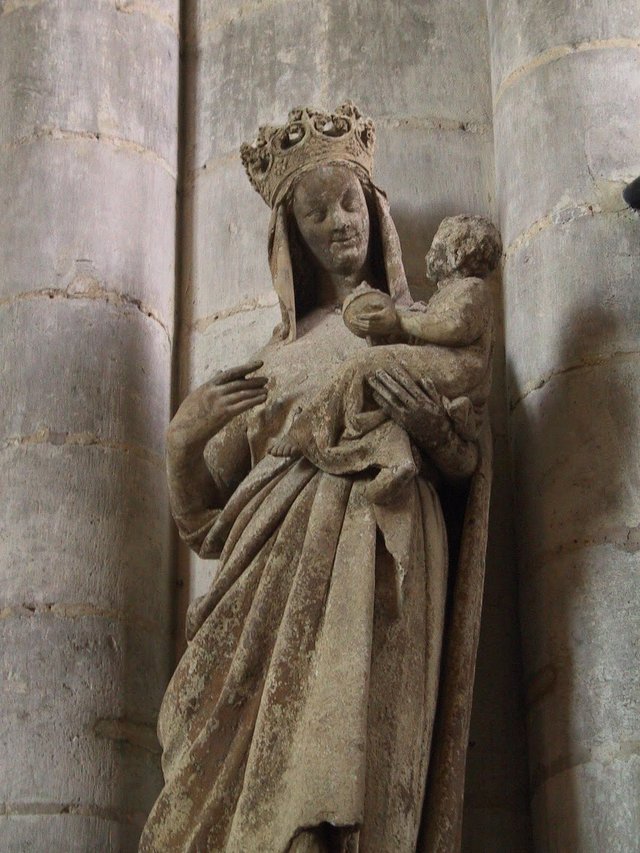
Otra Virgen sonriente y precursora de la de León es la Virgen de la catedral de Amiens.
Por eso decimos que la catedral de León y la de Burgos tienen influencia francesa.
Another smiling Virgin and precursor of the one of Leon is the Virgin of the cathedral of Amiens.
That is why we say that the cathedral of León and that of Burgos have French influence.
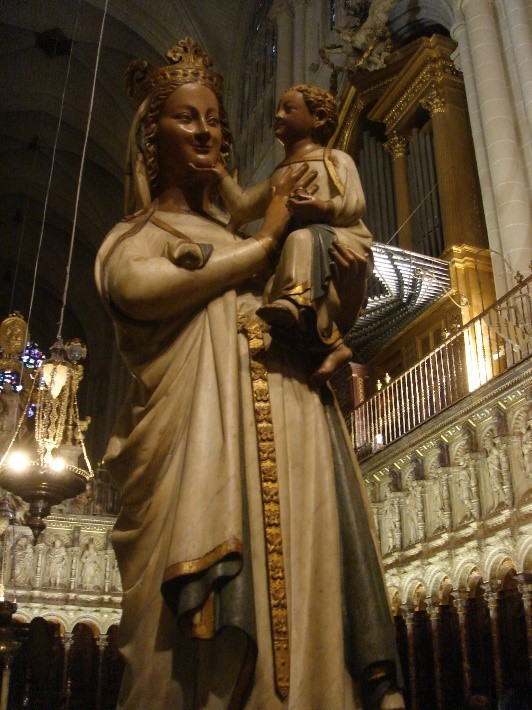
http://domuspucelae.blogspot.com.es/2012/08/visita-virtual-la-virgen-blanca.html
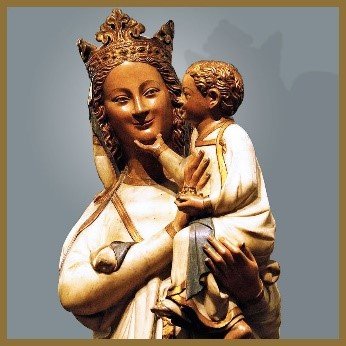
http://domuspucelae.blogspot.com.es/2012/08/visita-virtual-la-virgen-blanca.html
En la Catedral de Burgos hay otra Virgen Blanca. Para mi, es más tierna aún que la de León. La Virgen y el niño se tocan y acarician la cara. Es realmente entrañable.
In the Cathedral of Burgos there is another White Virgin. For me, it is even more tender than Leon's. The Virgin and the child touch and caress the face. It is really endearing.
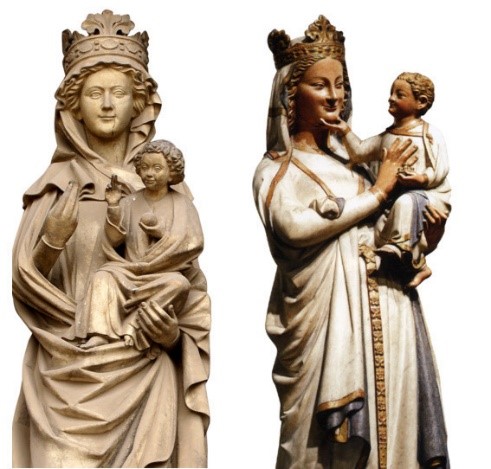
Aquí podéis comparar ambas Vírgenes Blancas que se llaman así por el material claro con el que están esculpidas.
Here you can compare both White Virgins that are named for the clear material with which they are sculpted.
Uno de los elementos más bonitos de la catedral de León son sus pórticos, a parte de las vidrieras (ya he realizado anteriormente un post que podéis disfrutar y en el que explico esta maravilla artística medieval).
One of the most beautiful elements of the Cathedral of León are its porticos, apart from the stained glass windows (I have previously done a * post * that you can enjoy and in which I explain this medieval artistic wonder).
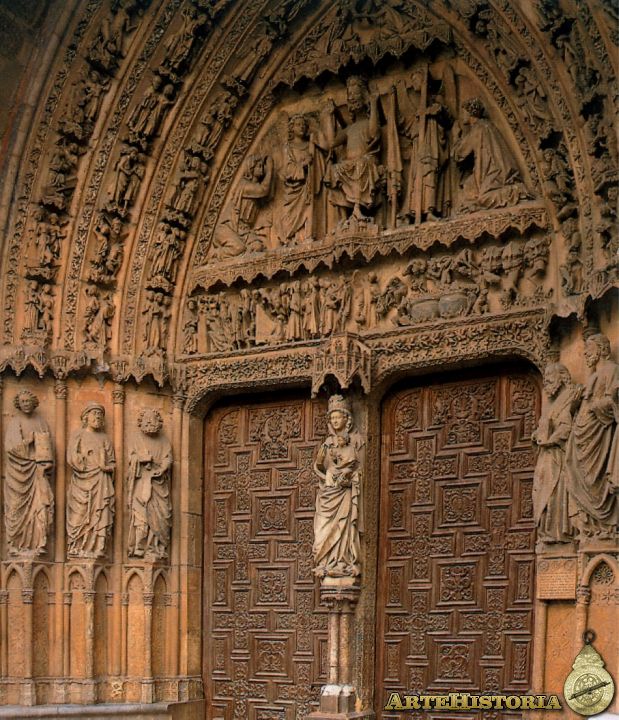
https://www.artehistoria.com/es/obra/catedral-de-le%C3%B3n-puerta-del-juicio
Las portadas de la Catedral de León se realizaron en la segunda mitad del siglo XIII y son el máximo exponente de la escultura gótica española. El pórtico de la fachada occidental de la Catedral de León tiene tres portadas. En la central está la imagen de la Virgen Blanca justo en el centro, en el denominado parteluz.
The covers of the Cathedral of León were made in the second half of the 13th century and are the maximum exponent of Spanish Gothic sculpture. The portico of the western facade of the Cathedral of Leon has three covers. In the center is the image of the White Virgin right in the center, in the so-called mullion.
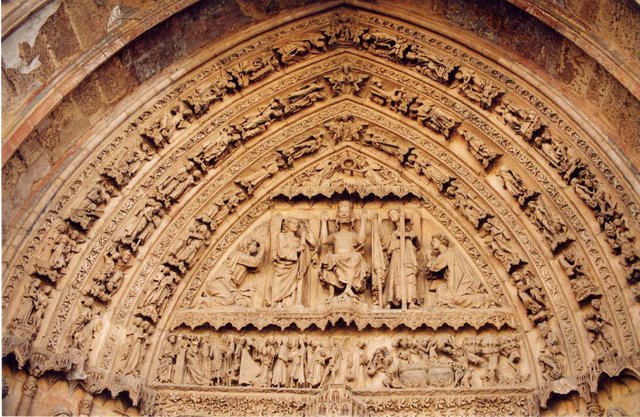
Esta portada también se ha denominado la del Juicio final. El Cristo Juez mostrando sus heridas preside y a su alrededor están los ángeles con los instrumentos de su martirio. La Virgen y San Juan están arrodillados intercediendo por nosotros. Bajo este nivel se desarrolla el Juicio Final. San Miguel pesa las almas y separa a los bienaventurados que irán al paraíso (incluidos Alfonso X o san Francisco, que aparecen con varios instrumentos de música), de los condenados que sufrirán los tormentos del infierno, devorados por demonios o hervidos en calderos. En contraposición también aparecen escenas de la resurrección de los santos.
Under this level the Final Judgment is developed. San Miguel weighs souls and separates the blessed who will go to paradise (including Alfonso X or San Francisco, who appear with various musical instruments), of the condemned who will suffer the torments of hell, devoured by demons or boiled in cauldrons. In contrast, scenes of the resurrection of the saints also appear. This cover has also been called this cover the Final Judgment. The Judge Christ showing his wounds presides and around him are the angels with the instruments of his martyrdom. The Virgin and Saint John are kneeling interceding for us.
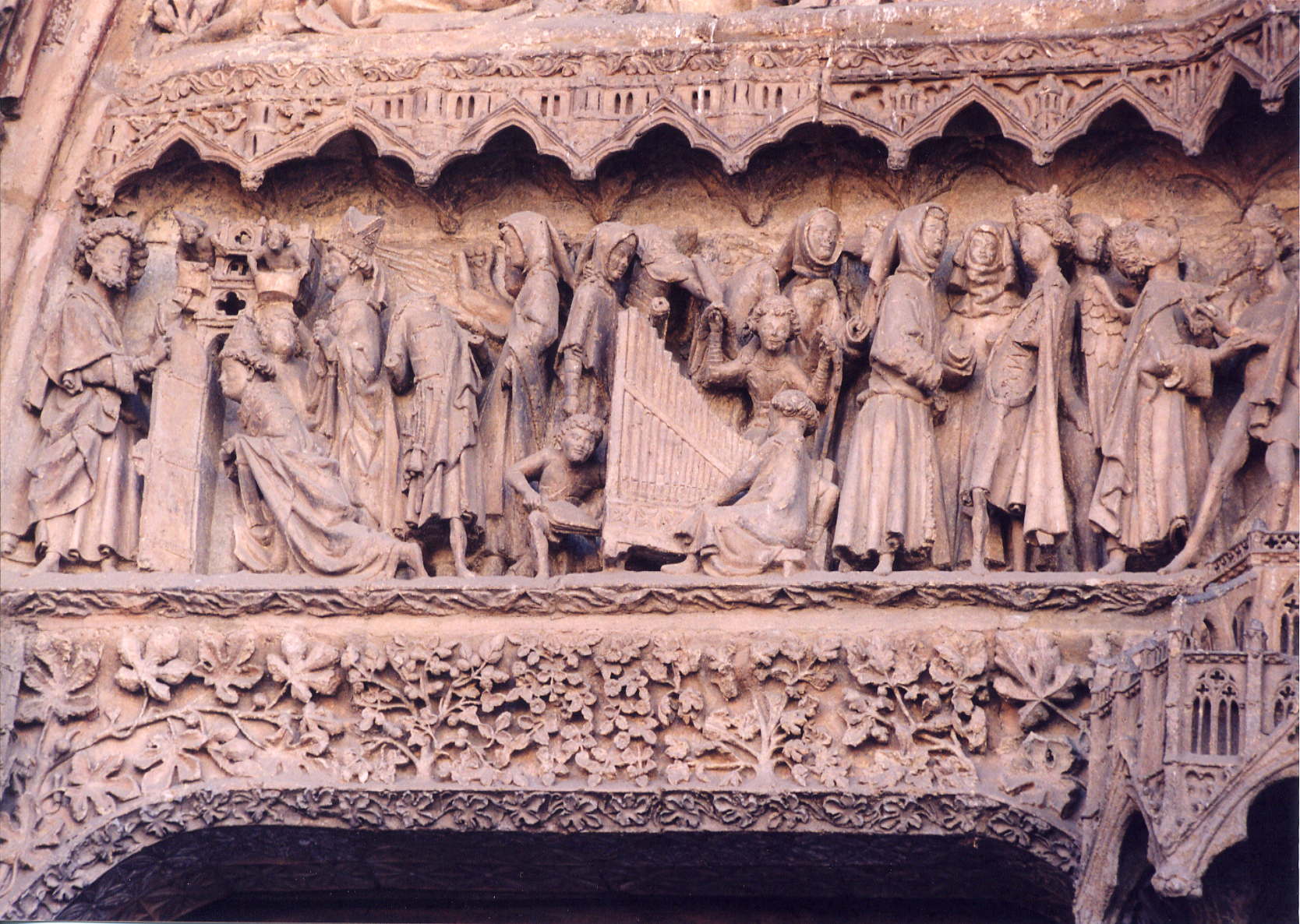
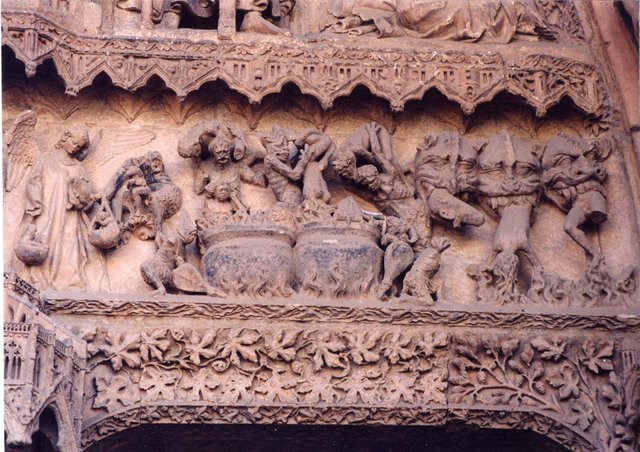
En la portada principal se representa el Juicio Final y en ella se evidencia la influencia francesa. De esta, destacan los personajes de las jambas y Nuestra Señora La Blanca en el parteluz. Las figuras se presentan con naturalidad como es propio del estilo gótico. Sus ropas tienen pliegues y los rostros tienen expresión. Las figuras adoptan formas individualizadas. Hay sensación de movimiento. Estas son las principales características del gótico, a diferencia del estilo románico que es más simbólico y con figuras más estáticas.
On the main cover the Last Judgment is represented and it shows the French influence. Of this, stand out the characters of the jambs and Our Lady The White in the mullion. The figures are presented naturally as is typical of the Gothic style. Their clothes have folds and the faces have expression. The figures adopt individualized forms. There is a feeling of movement. These are the main characteristics of Gothic, unlike the Romanesque style that is more symbolic and with more static figures.
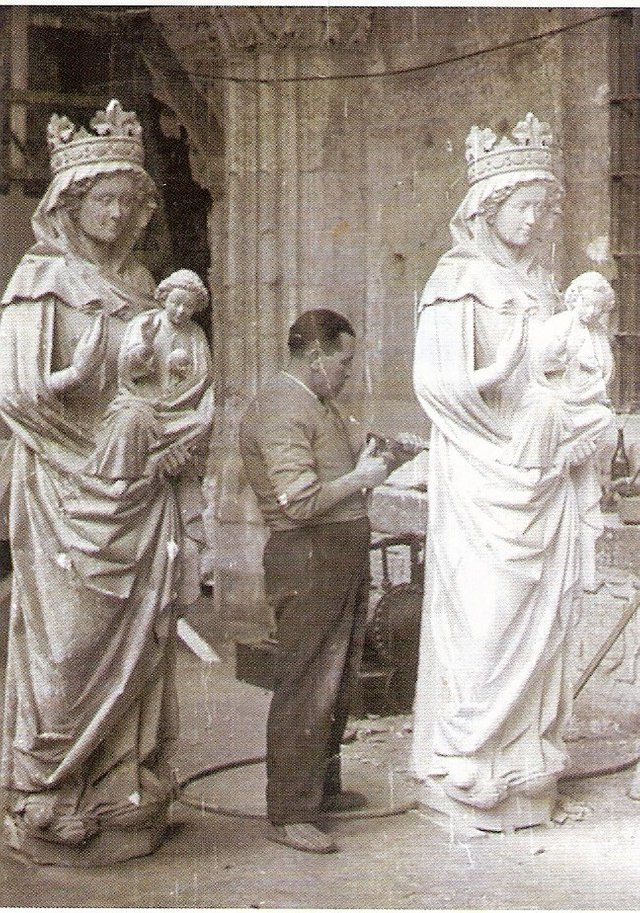
es.wikipedia.org/wiki/Andr%C3%A9s_Seoane#/media/File:Andr%C3%A9s_Seoane.jpg
La estatua original de la Virgen Blanca está en el interior en una capilla. Se realizó una copia por el escultor Andrés Seoane y esta copia es la que está en el parteluz del pórtico. Con ello se ha intentado salvaguardar la escultura original y protegerla, ya que comenzaba a deteriorarse. A mi personalmente, me parece que la naturalidad y humanidad de la escultura original no la consigue el escultor con su copia. En la Capilla de la Virgen Blanca se guarda la imagen original desde 1954.
The original statue of the White Virgin is inside in a chapel. A copy was made by the sculptor Andrés Seoane and this copy is the one in the mullion of the portico. This has tried to safeguard the original sculpture and protect it, as it began to deteriorate. To me personally, it seems to me that the naturalness and humanity of the original sculpture is not achieved by the sculptor with his copy. In the Chapel of the White Virgin the original image is kept since 1954.
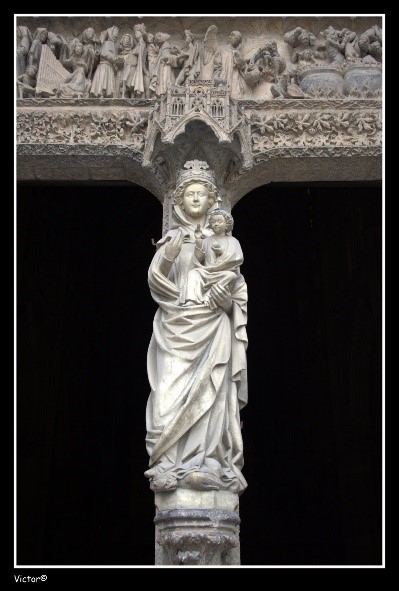
http://poramoralarte3.blogspot.com.es/2011/03/virgen-blanca-de-la-catedral-de-leon.html
En resumen: la Virgen sonríe porque es moderna. Es el gótico que llega y se impone sobre el románico. Los ídolos eclesiásticos muestran humanidad. La virgen como madre promete colaborar en el momento del Juicio Final intercediendo. Con su sonrisa trasmite esperanza y devoción.
Por eso sonríe la Virgen Blanca.
In summary: the Virgin smiles because she is modern. It is the Gothic that arrives and imposes itself on the Romanesque. The ecclesiastical idols show humanity. The virgin as a mother promises to collaborate at the moment of the Final Judgment interceding. With his smile, he transmits hope and devotion.
That's why the White Virgin smiles.
Bibliografía:
Bibliography:
http://domuspucelae.blogspot.com.es/2012/08/visita-virtual-la-virgen-blanca.html
Si te gustó este post puedes votarlo o resteem y así lo conservas en tu blog.
¡Espero tus comentarios!
If you liked this * post * you can vote or resteem it and keep it in your blog.
I await your comments!

¡Buen Camino!
¡Que curioso! Jamás me habría dado cuenta del detalle.
Si es muy curioso. Me llamó la atención. 😉
Enhorabuena por tu post de la casa de Cervantes. 👏👏👏